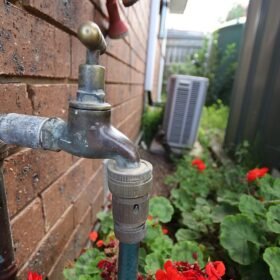If you’re a gardener, the winter months present an opportunity to enjoy your garden even more. Winter is the time for pruning and planting, so that next year’s flowers will be even more beautiful than the ones you see now. If you’re not particularly skilled at gardening but still want to create a lovely backyard space, start with these tips:
Place evergreen plants at eye level.
You can use evergreen plants to create privacy in your garden, as well as block wind and noise. When planting them around windows, make sure you don’t plant them too close to the house or window frame. If you have a noisy neighbour with a barking dog, for example, planting evergreens outside their windows may help muffle their noise so they can sleep better at night.
Aromatic herbs such as rosemary and lavender are also good choices for this type of gardening because they not only provide color but also fragrance throughout the colder months indoors when used in cooking or potpourri making!
Incorporate winter flowering shrubs in your design.
Evergreen plants are often the best choice for winter, but if you prefer to have some colour during this time of year, choose shrubs with berries or berries. Some other good picks include those that flowers in winter, such as the viburnum and hawthorn trees.
You may also want to consider planting shrubs which attract birds: some examples include cotoneasters, snowball bushes and spirea. These types of plants can help create a habitat for birds by providing them food sources during the colder months when not much else is growing outdoors.
Finally, consider planting shrubs that attract wildlife such as deer or rabbits—these plants provide food sources and protection from predators so they’re able to survive through the colder months without having any problems!
Grow seasonal vegetables.
One of the best ways to get your garden started is to plant some vegetables in the fall and watch them grow over the winter. Root vegetables are especially well-suited for this, as they can be planted in late summer or early fall and harvested throughout the cold months.
Vegetable gardening doesn’t have to end with summer! You can still enjoy fresh produce if you’re willing to put in a bit of extra work—and it’s much healthier than relying on canned or frozen varieties during those long winter nights.
Also Read: When is The Best Time to Plant a Garden
Use a tree to create a focal point.
Trees are a great way to create a focal point in your garden and can also be used to block views of unsightly areas.
- Use single trees as focal points. A single tree will draw attention, but it shouldn’t overpower everything else in the garden. Try using one that has a particularly interesting shape or colouring—a silhouette against the sky will look good at night when lit up by streetlights, too!
- Use multiple trees to mask an unattractive view. If you don’t want your guests looking at an ugly fence or house across the street, plant some tall shrubs around your house so they block it out. You could even use them as support for climbing roses and other flowering plants if you like!
- Use a tree as a privacy screen between neighbours’ yards/buildings/fences etc if there isn’t any natural fence between them (such as hedges). For example: let’s say two neighbours both have backyards separated only by dirt paths—you could plant large bushes next to each path where they meet so no one can see what’s going on inside each yard without first entering said bush(es).
Frame your garden.
The right frame can make all the difference in the world. Framing your garden will highlight its best features, while camouflaging others. Here are some options:
- Trees and shrubs: You can use deciduous trees or evergreen shrubs to frame your garden by placing them at the edges of your property. This provides privacy as well as an opportunity to showcase decorative bark patterns.
- Fencing: A fence is another way to help define boundaries and give definition to a space. Choose fencing materials that match the style of your home and complement your overall landscape aesthetic. Fences should be at least 6′ high for privacy reasons, but if you want even more protection from people peering over fences into your yard, consider adding taller fencing material like bamboo or cedar wood planks (which also provides extra privacy from nosy neighbors).
Make use of the sun by having a south facing garden.
- Sunlight is the best source of energy for plants and also gives them their color.
- The amount of sunlight a plant receives depends on where you live as well as what time of day you are gardening.
- If you want your garden to get the most sun, choose a south facing garden. South facing gardens will have plenty of sunlight in the morning and afternoon when your area gets most sun each day (this varies depending on where you are).
- South facing gardens will also be warmer than north or east-facing ones because they get more direct sunlight throughout the day and have no shade from trees growing between them and the sun’s rays (like with north/east-facing gardens). This means that plants in these locations can grow faster, larger, and longer than if they were planted somewhere else in your yard! However…
Plant flowers that attract birds and wildlife.
In the winter, it’s easy to forget that your garden is still alive and well. But you can use your garden to create a habitat for birds and other wildlife, even when it’s cold outside.
- Choose plants that are native to your region. These plants will be more likely to survive in the harsh winter climate, so they’ll provide food for birds year-round.
- Consider planting perennials or shrubs that grow on their own—they’ll come back year after year without requiring much maintenance from you.
- Add an artificial birdbath or two to your yard so that birds can drink water during the cold months when natural sources aren’t available.
You can have an appealing backyard even in the coldest months!
You don’t need to wait for spring to start creating an appealing backyard. Even in the coldest months, you can still have a garden that’s beautiful and functional.
- First, consider your plants. Don’t be afraid to use those that have been classified as “evergreen.” These can be used all year round and will help keep the garden looking full and attractive. You can also add seasonal color by using annuals that are available in spring and summer. And don’t forget about ground covers! They’re great for adding visual interest without requiring much maintenance or care.
- Next, consider your hardscape. If you have a patio or deck, make sure it’s clear of snow so that it can be enjoyed even when it’s chilly outside. You may also want to add some deck furniture or potted plants that provide additional seating options for your guests so they can relax outdoors even when there’s no sun out yet (or if there ever is).
- Finally, think about lighting! This is one area where you might want to spend a bit more money because it can really make all the difference when it comes time for dinner parties or just sitting around chatting with friends under the stars after dinner.
If you follow the tips we’ve given here, you’ll be able to create an attractive garden in winter. You can even bring some color into your yard if you use the right plants and make sure that they are properly cared for Find out more about garden supplies at Aumann’s!








